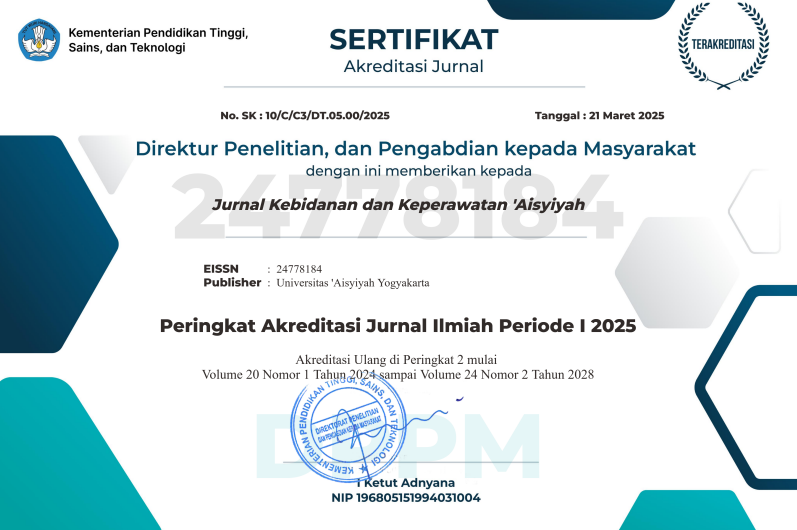Using fire cupping therapy to enhance early lactation to prevent stunting in coastal regions
DOI:
https://doi.org/10.31101/jkk.3807Abstract views 586 times
Keywords:
initiation of breastfeeding, early lactation, fire cupping therapy, LATCH score, PostpartumAbstract
Downloads
References
ACOG. (2021). Breastfeeding Challenges. Obstetrics & Gynecology, 137(2). https://www.acog.org/clinical/clinical-guidance/committee opinion/articles/2021/02/breastfeeding-challenges
Aksu, S., & Palas Karaca, P. (2021). The Effect of Reflexology on Lactation in Women Who Had Cesarean Section: A Randomized Controlled Pilot Study. Complementary Medicine Research, 28(4), 336–343. https://doi.org/10.1159/000513924
An, S. K., Kim, K. W., Lee, H. L., Lee, T. W., Kim, E. S., Lee, B. R., & Yang, G. Y. (2021). An Experimental Study on the Pressure Range of Fire Cupping Method. Journal of Acupuncture Research, 38(3), 200–204. https://doi.org/10.13045/jar.2021.00080
Coban, A., Bayraktar, S., Yıldız, N., Tunçel, D., Gökçay, G., & Ince, Z. (2021). A Case Study of Early Postpartum Excessive Breast Engorgement: Is it Related to Feedback Inhibition of Lactation? Journal of Human Lactation, 37(2), 414–418. https://doi.org/10.1177/0890334420962073
Cooklin, A. R., Amir, L. H., Nguyen, C. D., Buck, M. L., Cullinane, M., Fisher, J. R. W., & Donath, S. M. (2018). Physical health, breastfeeding problems and maternal mood in the early postpartum: A prospective cohort study. Archives of Women’s Mental Health, 21(3), 365–374. https://doi.org/10.1007/s00737-017-0805-y
de Onis, M., & Branca, F. (2016). Childhood stunting: A global perspective. Maternal and Child Nutrition, 12, 12–26. https://doi.org/10.1111/mcn.12231
Ekholuenetale, M., Barrow, A., Ekholuenetale, C. E., & Tudeme, G. (2020). Impact of stunting on early childhood cognitive development in Benin: Evidence from Demographic and Health Survey. Egyptian Pediatric Association Gazette, 68(1). https://doi.org/10.1186/s43054-020-00043-x
Fang, Y. W., Chen, S. F., Wang, M. L., & Wang, M. H. (2024). Effects of traditional Chinese medicine-assisted intervention on improving postpartum lactation: A systematic review and meta-analysis. Heliyon, 10(6), e27154. https://doi.org/10.1016/j.heliyon.2024.e27154
Gayatri, M., & Dasvarma, G. L. (2020). Predictors of early initiation of breastfeeding in Indonesia: A population-based crosssectional survey. PLoS ONE, 15(9 September), 1–15. https://doi.org/10.1371/journal.pone.0239446
Gianni, M. L., Bettinelli, M. E., Manfra, P., Sorrentino, G., Bezze, E., Plevani, L., Cavallaro, G., Raffaeli, G., Crippa, B. L., Colombo, L., Morniroli, D., Liotto, N., Roggero, P., Villamor, E., Marchisio, P., & Mosca, F. (2019). Breastfeeding Difficulties and Risk for Early Breastfeeding Cessation. Nutrients, 11(10), 2266. https://doi.org/10.3390/nu11102266
Haron, M. Z., Jalil, R. A., Hamid, N. A. A., Omar, M. A., & Abdullah, N. H. (2023). Stunting and Its Associated Factors among Children Below 5 Years Old on the East Coast of Peninsular Malaysia: Evidence from the National Health and Morbidity Survey. Malaysian Journal of Medical Sciences, 30(5), 155–168. https://doi.org/10.21315/mjms2023.30.5.13
Huck, W. (2022). Goal 2 End hunger, achieve food security and improved nutrition and promote sustainable agriculture End hunger, achieve food security. Sustainable Development Goals, 125–152. https://doi.org/10.5771/9783748902065-125
Jensen, D., Wallace, S., & Kelsay, P. (1994). LATCH: A breastfeeding charting system and documentation tool. Journal of Obstetric, Gynecologic, and Neonatal Nursing: JOGNN, 23(1), 27–32. https://doi.org/10.1111/j.1552-6909.1994.tb01847.x
Kasajja, M., Nabiwemba, E., Wamani, H., & Kamukama, S. (2022). Prevalence and factors associated with stunting among children aged 6–59 months in Kabale district, Uganda. BMC Nutrition, 8(1), 79. https://doi.org/10.1186/s40795-022-00578-9
Kementerian Kesehatan Republik Indonesia. (2022). Buku Saku: Hasil Survei Status Gizi Indonesia (SSGI) 2022.
Kementerian Kesehatan RI. (2021). Buku Saku Hasil Studi Status Gizi Indonesia (SSGI). https://doi.org/10.36805/bi.v2i1.301
Kementerian Kesehatan RI. (2023). Dua Fokus Intervensi Penurunan Stunting untuk Capai Target 14% di Tahun 2024.
Kurniawan, L. C., & Agustijaya, O. (2019). Pengaruh Titik Akupunktur ST 18, GB 21, CV 17 terhadap Peningkatan Volume ASI Ibu Menyusui di BPS E Malang. 7(1).
Liu, J., Chen, H., Wang, W., & Zhao, D. (2022). Application of Traditional Chinese Medical Science Characteristic Nursing Mode Based on Evidence-Based Medicine to Puerperal Breast Tenderness and Pain. Evidence-Based Complementary and Alternative Medicine, 2022. https://doi.org/10.1155/2022/7527890
Machmudah, M., Khayati, N., Widodo, S., Hapsari, E. D., & Haryanti, F. (2020). Improvement of Prolactin Hormone Levels on Postpartum Mothers Taken by The Oketani Massage and Pressure in GB-21 Point. IJNP (Indonesian Journal of Nursing Practices), 4(1). https://doi.org/10.18196/ijnp.41101
Majeed, S., Majeed, M., & Ajike, M. A. (2019). Dry cupping therapy and the wellness management of health travelers Modernization of Traditional Medicine. Traditional Medicine Research, 4(1), 12–24. https://doi.org/10.12032/TMR201915095
Meyling, M. M. G., Frieling, M. E., Vervoort, J. P. M., Jong, E. I. F., & Danielle, E. (2023). Health problems experienced by women during the first year postpartum: A systematic review. 1–20.
Mogensen, N., Portman, A., & Mitchell, K. (2020). Nonpharmacologic Approaches to Pain, Engorgement, and Plugging in Lactation: Applying Physical Therapy Techniques From Breast Cancer Care to Breastfeeding Patients. Clinical Lactation, 11(1), p35.
Mohamed, A. A., Zhang, X., & Jan, Y. K. (2023). Evidence-based and adverse-effects analyses of cupping therapy in musculoskeletal and sports rehabilitation: A systematic and evidence-based review. Journal of Back and Musculoskeletal Rehabilitation, 36(1), 3–19. https://doi.org/10.3233/BMR-210242
NEOVITA Study Group. (2016). Timing of initiation, patterns of breastfeeding, and infant survival: Prospective analysis of pooled data from three randomised trials. The Lancet. Global Health, 4(4), e266-275. https://doi.org/10.1016/S2214-109X(16)00040-1
Nurfatimah, N., Ramadhan, K., Entoh, C., Longgupa, L. W., & Hafid, F. (2021). Continuity of Midwifery Care Implementation to Reduce Stunting. Open Access Macedonian Journal of Medical Sciences, 9(E), 1512–1516. https://doi.org/10.3889/oamjms.2021.7062
Patil, C. L., Turab, A., Ambikapathi, R., Nesamvuni, C., Chandyo, R. K., Bose, A., Islam, M. M., Ahmed, A. S., Olortegui, M. P., De Moraes, M. L., Caulfield, L. E., & on behalf of the MAL-ED network. (2015). Early interruption of exclusive breastfeeding: Results from the eight-country MAL-ED study. Journal of Health, Population and Nutrition, 34(1), 10. https://doi.org/10.1186/s41043-015-0004-2
Ponum, M., Khan, S., Hasan, O., Mahmood, M. T., Abbas, A., Iftikhar, M., & Arshad, R. (2020). Stunting diagnostic and awareness: Impact assessment study of sociodemographic factors of stunting among school-going children of Pakistan. BMC Pediatrics, 20(1), 1–9. https://doi.org/10.1186/s12887-020-02139-0
Pope, C. J., & Mazmanian, D. (2016). Breastfeeding and postpartum depression: An overview and methodological recommendations for future research. Depression Research and Treatment, 2016. https://doi.org/10.1155/2016/4765310
Raihana, S., Dibley, M. J., Rahman, M. M., Tahsina, T., Siddique, M. A. B., Rahman, Q. S., Islam, S., Alam, A., Kelly, P. J., Arifeen, S. E., & Huda, T. M. (2019). Early initiation of breastfeeding and severe illness in the early newborn period: An observational study in rural Bangladesh. PLoS Medicine, 16(8), e1002904. https://doi.org/10.1371/journal.pmed.1002904
Raiten, D. J., & Bremer, A. A. (2020). Exploring the nutritional ecology of stunting: New approaches to an old problem. Nutrients, 12(2). https://doi.org/10.3390/nu12020371
Smith, E. R., Locks, L. M., Manji, K. P., McDonald, C. M., Kupka, R., Kisenge, R., Aboud, S., Fawzi, W. W., & Duggan, C. P. (2017). Delayed Breastfeeding Initiation is Associated with Infant Morbidity. The Journal of Pediatrics, 191, 57-62.e2. https://doi.org/10.1016/j.jpeds.2017.08.069
Stuebe, A. M., Horton, B. J., Chetwynd, E., Watkins, S., Grewen, K., & Meltzer-Brody, S. (2014). Prevalence and risk factors for early, undesired weaning attributed to lactation dysfunction. Journal of Women’s Health, 23(5), 404–412. https://doi.org/10.1089/jwh.2013.4506
Swanida, N., Malonda, H., Arthur, P., & Kawatu, T. (2020). History of Exclusive Breastfeeding and Complementary Feeding as a Risk Factor of Stunting in Children Age 36-59 Months in Coastal Areas. Journal of Health, Medicine and Nursing, 70, 52–57. https://doi.org/10.7176/jhmn/70-07
Talbert, A., Jones, C., Mataza, C., Berkley, J. A., & Mwangome, M. (2020). Exclusive breastfeeding in first-time mothers in rural Kenya: A longitudinal observational study of feeding patterns in the first six months of life. International Breastfeeding Journal, 15(1), 1–9. https://doi.org/10.1186/s13006-020-00260-5
Tosun, H., & Pinar, G. (2021). Effectiveness of Dry Cupping Therapy Combined with Breast and Oxytocin Massage on Early Lactation: A Case Report. EC Nursing Healthcare, 3(3), 18–23.
UNICEF. (2018). Breastfeeding: A mother’s gift, for every child—UNICEF DATA. Unicef, 1–13.
Vonaesch, P., Randremanana, R., Gody, J. C., Collard, J. M., Giles-Vernick, T., Doria, M., Vigan-Womas, I., Rubbo, P. A., Etienne, A., Andriatahirintsoa, E. J., Kapel, N., Brown, E., Huus, K. E., Duffy, D., Finlay, B. B., Hasan, M., Hunald, F. A., Robinson, A., Manirakiza, A., … Gouandjika-Vassilache, I. (2018). Identifying the etiology and pathophysiology underlying stunting and environmental enteropathy: Study protocol of the AFRIBIOTA project. BMC Pediatrics, 18(1), 1–18. https://doi.org/10.1186/s12887-018-1189-5
WHO. (2018). Reducing Stunting In Children.
WHO. (2023). Levels and Trends in Child Malnutrition Child Malnutrition: Key Findings of the 2023 Edition (1st ed). World Health Organization.
Witt, A. M., Bolman, M., Kredit, S., & Vanic, A. (2016). Therapeutic Breast Massage in Lactation for the Management of Engorgement, Plugged Ducts, and Mastitis. Journal of Human Lactation, 32(1), 123–131. https://doi.org/10.1177/0890334415619439
World Health Organization Special Programme of Research, D. (2022). WHO recommendations on maternal and newborn care for a positive postnatal experience. In World Health Organization.
Yimer, T. S., Sisay, F. A., Belay, H. G., Mihretie, G. N., Dagnaw, E. H., & Ferede, W. Y. (2024). Early Post-natal Care Services Utilization and its associated factors among mothers Systemic Review and Meta-Analysis. Heliyon, 10(1), e23760. https://doi.org/10.1016/j.heliyon.2023.e23760
Zabidi, N. A., Nazri, F., Syafinaz, I., Amin, M., Salahuddin, M., Basri, M., Basha, R. K., & Othman, S. H. (2023). Early Post-natal Care Services Utilization and its associated factors among mothers Systemic Review and Meta-Analysis. International Journal of Biological Macromolecules, 2(2), 33–47. https://doi.org/10.1016/j.heliyon.2023.e23760
Downloads
Published
How to Cite
Issue
Section
License
Copyright (c) 2025 Jurnal Kebidanan dan Keperawatan Aisyiyah

This work is licensed under a Creative Commons Attribution-ShareAlike 4.0 International License.
With the receipt of the article by the Jurnal Kebidanan dan Keperawatan Aisyiyah Editorial Board and the decision to be published, then the copyright regarding the article will be diverted to Jurnal Kebidanan dan Keperawatan Aisyiyah. Universitas 'Aisyiyah Yogyakarta as the publisher of Jurnal Kebidanan dan Keperawatan Aisyiyah hold the copyright regarding all the published articles in this journal.
Jurnal Kebidanan dan Keperawatan Aisyiyah is licensed under a Creative Commons Attribution-ShareAlike 4.0 International License.
















